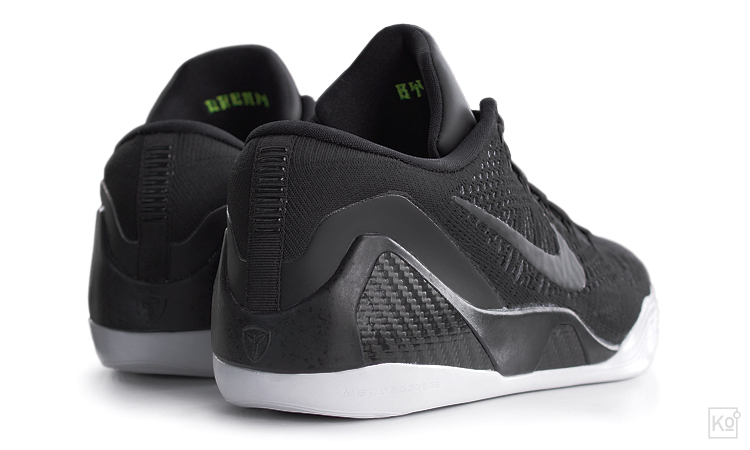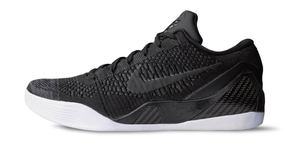The KOBE 9 may mark the end of the Black Mamba’s on-court career, but, sad as that would be, this stunning shoe would represent one hell of a closing act.
As I noted when I re-booted Kicksology.net last September, I won’t be writing any new performance reviews—the reason being that my body is too broke-down to play anything beyond a game of H-O-R-S-E these days. If you’re looking for thorough on-court assessments of the latest kicks, check out Nightwing, Mr Foamer Simpson or the guys at KicksGenius.
But the end of my playing days doesn’t mean the end of my irrational exuberance for footwear. So I’ll continue to highlight shoes that pique my interest, whether it’s for a clever design element, or the introduction of an important new method-of-making or an unusually beautiful fusion of form and function. The KOBE 9 Elite just so happens to deliver on all three of these counts, which is why I was willing to empty out my wallet and harvest all the change from behind my sofa cushions to purchase a pair of the Elite Lows via NIKEiD (yes, they’re spendy).
figure 1. Sneaker design legend Tinker Hatfield described the KOBE 9 as “one of the most iconic, most beautiful shoe designs I’ve ever seen.” Who am I to argue with greatness? One of my favorite aspects of the KOBE 9’s design are the subtle ridges molded into the rubber sidewalls that wrap up around the base of the toebox. To my eye, their organic curves echo the shoe’s beautiful, pressure map-inspired outsole, while also evoking the many threads that comprise the KOBE 9’s innovative Flyknit upper.
It might seem strange that I should post this on the day that Kobe’s next signature shoe, the Kobe X, is officially unveiled. But the X won’t hit store shelves until February 7th, so any sneaker aficionados out there who’ve slept on the KOBE 9 Elite still have a brief window to cop a shoe that I believe will go down as the most important chapter in a storied line of signature kicks. And it’s worth noting that I’m not alone in my admiration for the 9: None other than Tinker Hatfield—he of Air Jordans III through XV, amongst many other icons of sneaker history—described the KOBE 9 as “one of the most iconic, most beautiful shoe designs I’ve ever seen” in an interview with Complex TV’s “Quickstrike” crew.
So, what’s so great about the 9? Well, for starters, as Tinker observed, it’s just drop-dead gorgeous. Yeah, yeah, beauty is in the eye of the beholder and all that. But the allure of some works transcends individual subjectivity: Take Beethoven’s Symphony No. 9 in D Minor as one example, or the Jaguar E-Type as another. Like those universal classics, I’m convinced that the soul-stirring beauty of the KOBE 9 Elite High and Low will be recognized far-and-wide for decades to come.
figure 2. Among the many customization options available for the KOBE 9 Elite Low via NIKEiD is the ability to add an embroidered message to the inner side of the tongue. You can add a large, two-character “Short iD” (useful for jersey numbers or initials) and a smaller, eight-character “Long iD.” In my case, I’ve opted for the Long iD only, and included a reminder to myself to “Dream By Day.” This shot also offers a good look at the KOBE 9 Elite’s beautiful carbon fiber heel counter and lateral support wing. Given the relatively high cost of carbon fiber, the material is limited to the primo priced Elite versions of the shoe.
A critical enabler of the KOBE 9 Elite’s transcendent design is the innovative manufacturing method underpinning its upper: Nike Flyknit. For the past several centuries, shoe uppers have been constructed using a process industry folks call cut-and-sew. As the name suggests, this involves cutting small panels of material out of larger sheets, and then sewing or glueing those panels together to form a finished upper. The longevity of this basic process speaks to its utility, but there are some downsides.
First, joining panels of material together—whether through sewing or glueing—invariably introduces stiffness along the interface where those panels meet. Related to this point, it can be very challenging to add targeted performance features via cut-and-sew without sacrificing comfort. Say, for example, you want to build stretch into one region of an upper and support into another. This would require disparate panels of materials with the necessary properties to be joined, but the more panels you introduce, the greater the potential for discomfort along the stiffened seams where those panels meet. Finally, this process is inherently wasteful because it’s based on cutting small panels of non-uniform parts out of large, uniformly rectangular sheets. Manufacturers have developed clever software that enables them to maximize the parts yield from each large sheet, but, because shoe parts tend to be oddly shaped, there’s always some material left over (the scraps can be recycled, but there’s cost and energy associated with the recycling process, so it doesn’t fully mitigate the waste produced at the cutting stage).
figure 3. The medial view above provides a good look at the different stitch and fiber applications that Eric Avar references in his quote below. You can see that the toe box area of the KOBE 9 Elite features a much tighter knit to help keep the forefoot planted on the footbed during hard cuts, while the midfoot features a more open knit geometry to allow the upper to move with the foot through that crucial fit zone. Among the many cool features of Flyknit is the ability to engineer “tunnels” into the regions of the upper where the designer wants to deliver added lockdown by way of dynamic Flywire (in the shot above, you can see Flywire cables tunneling through the upper along the medial arch). The net result is great fit around the midfoot without the “board-y” feel sometimes associated with more traditional, multi-layer applications of Flywire.
What makes Flyknit remarkable from a design and manufacturing perspective is that it addresses all of these issues. Rather than attempt to explain this myself, I’ll turn to two people with much greater expertise on the topic: Nike CEO Mark Parker and Eric Avar, the creative mind behind the KOBE 9 and a footwear design legend in his own right.
Mark Parker: Flyknit is, in many respects, game-changing in terms of performance, in terms of design … It used to be largely cut-and-sew construction for many centuries, which is more of a collage, where pieces come together. Today, we’re working at a fiber level and at a pixel level … down to the millimeter. On top of that, it changes the game of manufacturing. You’re taking one of the most labor intensive parts of the manufacturing process and simplifying it. There’s a sustainability factor and in this [KOBE 9 Elite High], there’s about 50% less waste than in a conventional basketball shoe. If you look at running [models], it’s potentially 80 to 90% less waste.
Eric Avar: You can design the amount of stretch and breathability exactly where you want it. Between the stitch and the fibers, you can create an unbelievable amount of performance properties. In the forefoot, where you really want some lockdown and security against all of the lateral forces, you can use a certain type of stitch and a certain type of fiber. Then, through the midfoot, where you want more of a dynamic and secure fit, you use another stitch and fiber … Knit, from a design perspective, allows us to use so many variables, and it’s essentially a blank canvas that allows us to design from a functional standpoint and also from a visual standpoint, so it’s really amazing.
These quotes come from Sole Collector, which interviewed Mark Parker, Eric Avar and Kobe Bryant at the launch of the KOBE 9 Elite last February. And, just to be clear, the stitch- and fiber-level control over performance characteristics that Parker and Avar highlight above is all built into a single layer of Flyknit construction. In the case of running applications, that single layer can constitute the entire upper, meaning that overlays and seams joining disparate materials are effectively eliminated. The net result is sock-like comfort and fit combined with precisely tuned support; the dramatic reduction in waste material is a huge attendant benefit.
Sports involving lots of lateral movement—e.g. basketball, soccer and American football—generate so much shear force that the Flyknit construction has to be reinforced to keep the wearer’s foot planted on the shoe’s footbed. But, even so, the KOBE 9 Elite completely dispenses with traditional overlays and is, instead, reinforced internally using a stitch-less process that Nike calls “Fuse.” Much as in running, the promise is an upper that fits and feels like a natural extension of the foot, but with no compromise in the support and overall protection required for court sports.
figure 4. The KOBE 9 would get my vote for most beautiful outsole of any basketball shoe, stretching back to the original Converse Chuck Taylor. And the great thing is that its beauty runs more than just skin deep. Molded from an ultra-thin layer of rubber, the KOBE 9’s underfoot pressure map-inspired outsole design delivers tenacious grip, while also contributing to the shoe’s excellent court feel and feathery weight. But, unless you have an unlimited budget for shoes, I’d limit game time exposure to less abrasive indoor surfaces (note, however, that an ultra-durable XDR outdoor outsole option is available via NIKEiD).
One additional benefit of Flyknit is that a reduction in seams and overlays also nets a reduction in overall weight. In the case of the KOBE 9 Elite Low, the shoe tips the scales at a gossamer 13.7 ounces in a U.S. men’s 11. In all my years of Kicksology, only one shoe has bested this: the Nike Air Flight Lite II circa 2000 - 2001, which weighed a scant 13.5 ounces. But the Flight Lite II’s weight advantage came with a significant trade-off in playability—here’s how I concluded my review back in April of 2001: “the Nike Air Flight Lite II is unquestionably a light shoe [but] that lightness is a product of compromises that make the shoe less than ideal for people who play a quick cutting, hard slashing type of game.”
What’s remarkable about the KOBE 9 Elite is that it’s a featherweight that, by all accounts, punches well above its weight. In other words, you get the benefits of an ultra-light shoe without the compromises in support and protection typically associated with ultra-light kicks.
figure 5. Kobe’s signature shoe line has featured removable midsole construction since the VII, which was introduced in late 2011. There are pros and cons to this approach, but I’m a big fan because it enables a degree of court- and cushioning-feel that can’t be matched by more traditional midsole constructions. I can understand why some reviewers have said they would have loved a full-length or heel Zoom Air unit to augment the Lunarlon insert, but I’m partial to the purity of this foam-only approach. My favorite feature of the midsole is its textured surface, which gives my toes something to grab onto and helps keep my feet awake and active.
At this point, I could go on at length about the KOBE 9 Elite’s unique Lunarlon midsole insert, but I think I’ve blabbed enough. The TL;DR version of this post is this: Get a pair of the KOBE 9 Elite while you still can because you will regret sleeping on this future classic. I know that as an employee of the Swoosh I may not be seen as an impartial observer on this topic, but I was a sneakerhead long before I moved inside the berm, and all my sneakerhead instincts tell me that the KOBE 9 Elite is a shoe that matters—the sort of shoe that, like the Air Flightposite and Huarache 2K4 before it (both shoes designed by Eric Avar, btw), will serve as a frame of reference for much that follows. If that matters to you, procure a pair posthaste!
Who’s Worn It
Kobe Bryant (G- Los Angeles Lakers); DeMar DeRozan (G- Toronto Raptors); Manu Ginóbili (G- San Antonio Spurs); Andre Iguodala (G/SF- Golden State Warriors); Zach LaVine (G- Minnesota Timberwolves); J.R. Smith (G/SF- Cleveland Cavaliers); Dion Waiters (G- Oklahoma City Thunder); Nick Young (G/SF- Los Angeles Lakers)







